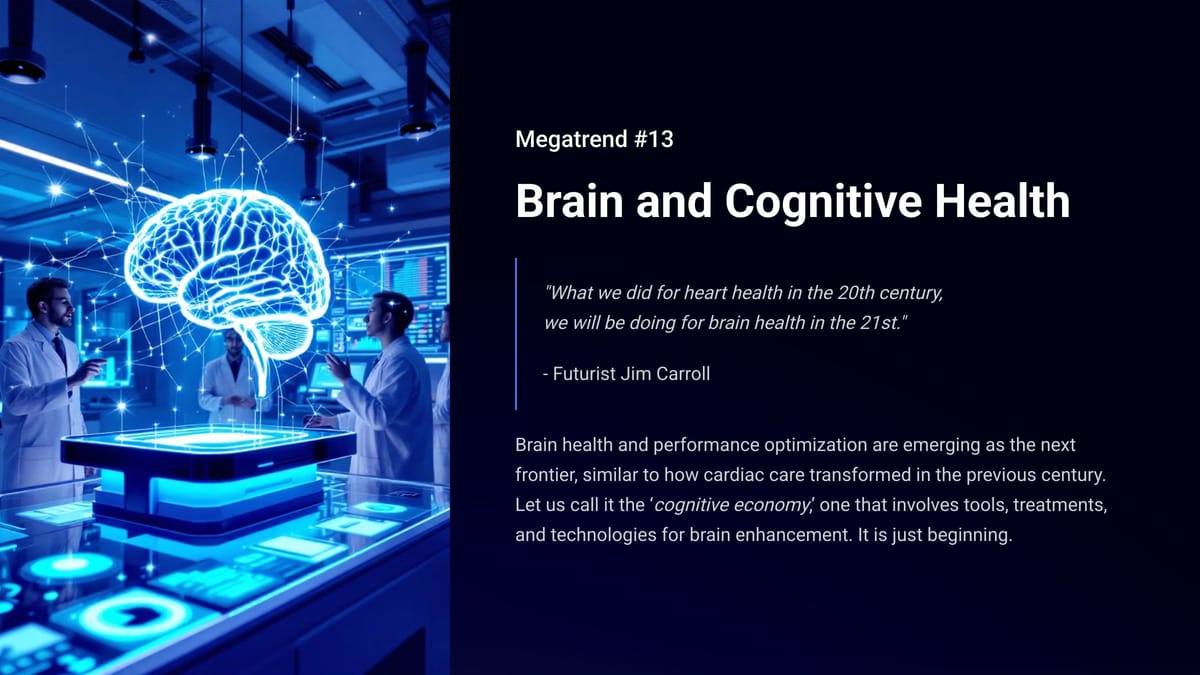"What we did for heart health in the 20th century, we will be doing for brain health in the 21st century." - Futurist Jim Carroll
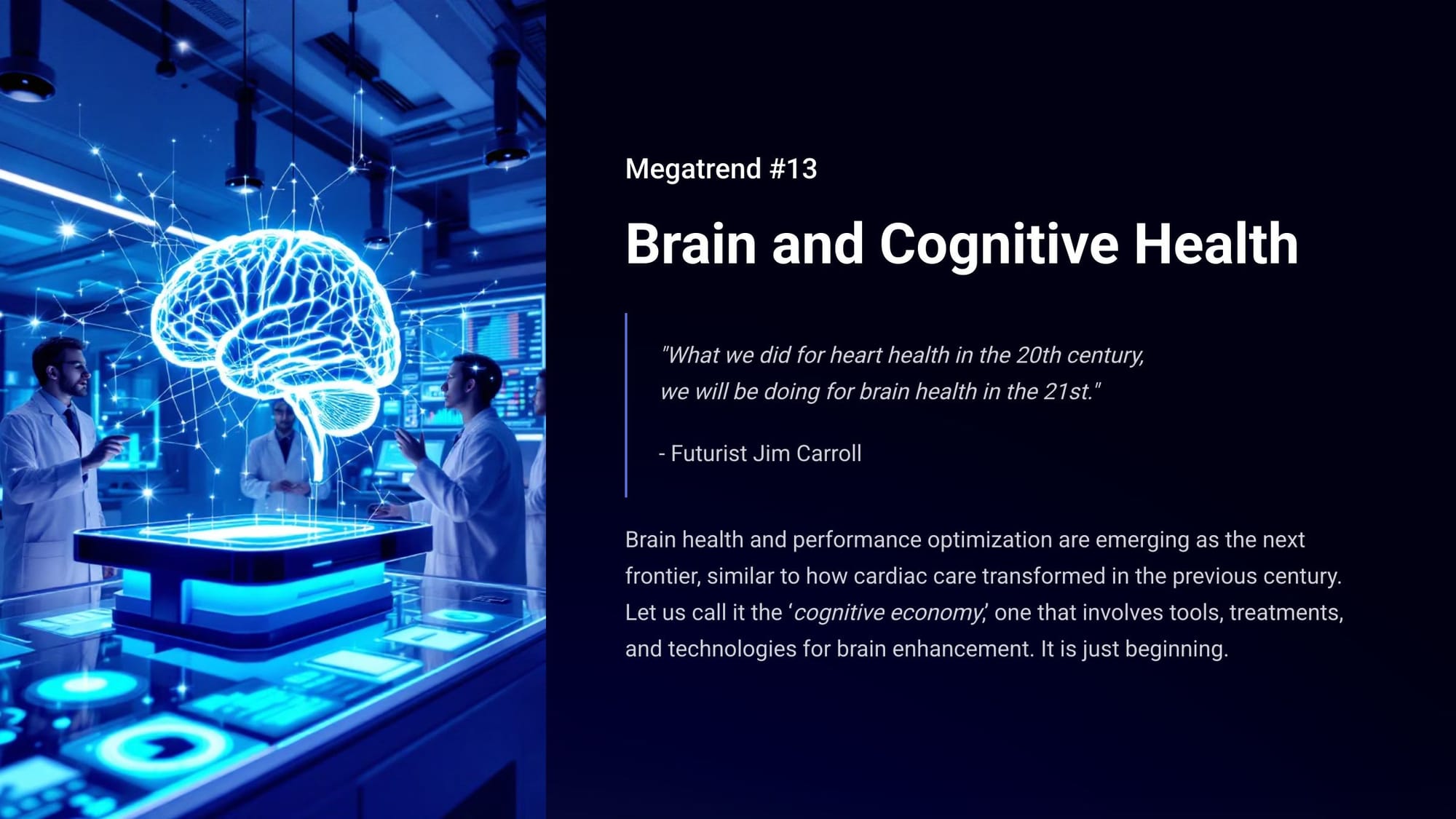
(Futurist Jim Carroll is writing a series on 30 Megatrends, which he first outlined in his book Dancing in the Rain: How Bold Leaders Grow Stronger in Stormy Times. The trends were shared in the book as a way of demonstrating that, despite any period of economic volatility, there is always long-term opportunity to be found. The book is now in print - learn more at dancing.jimcarroll.com)
Brain health and performance optimization are emerging as the next frontier, similar to how cardiac care transformed in the previous century. Let us call it the ‘cognitive economy,’ one that involves tools, treatments, and technologies for brain enhancement. It is just beginning. There's a full PDF report here.
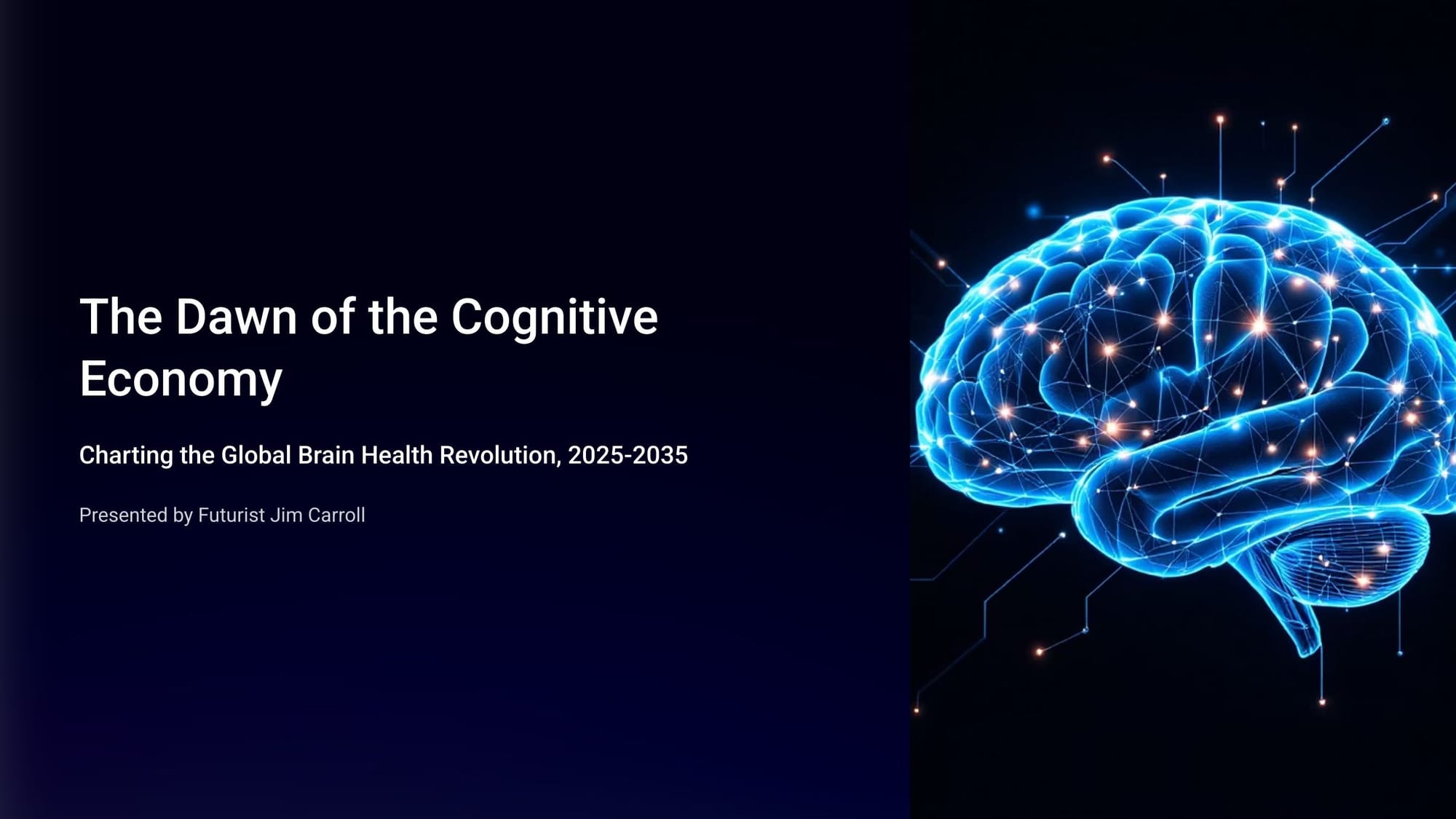
This revolution is giving rise to a new, multi-trillion-dollar "cognitive economy"—an ecosystem of science, technology, and services dedicated to understanding, preserving, and enhancing the human brain.
I've covered this trend in multiple ways before - with posts about the challenge of Alzheimer's to the acceleration of brain science, and combining those two trends. The fact is, we are witnessing a demographic tsunami with a profound demographic shift underway, creating an unprecedented challenge and opportunity for global health. How big a challenge?
- The global population aged 60 and over will double from 1.1 billion today to 2.1 billion by 2050.
- The number of persons aged 80 or older will triple between 2020 and 2050.
- By 2050, two-thirds of the world's population over 60 will live in low- and middle-income countries.
Many nations are becoming old before they become rich, lacking robust infrastructure to support aging populations. That's part one of this megatrend.
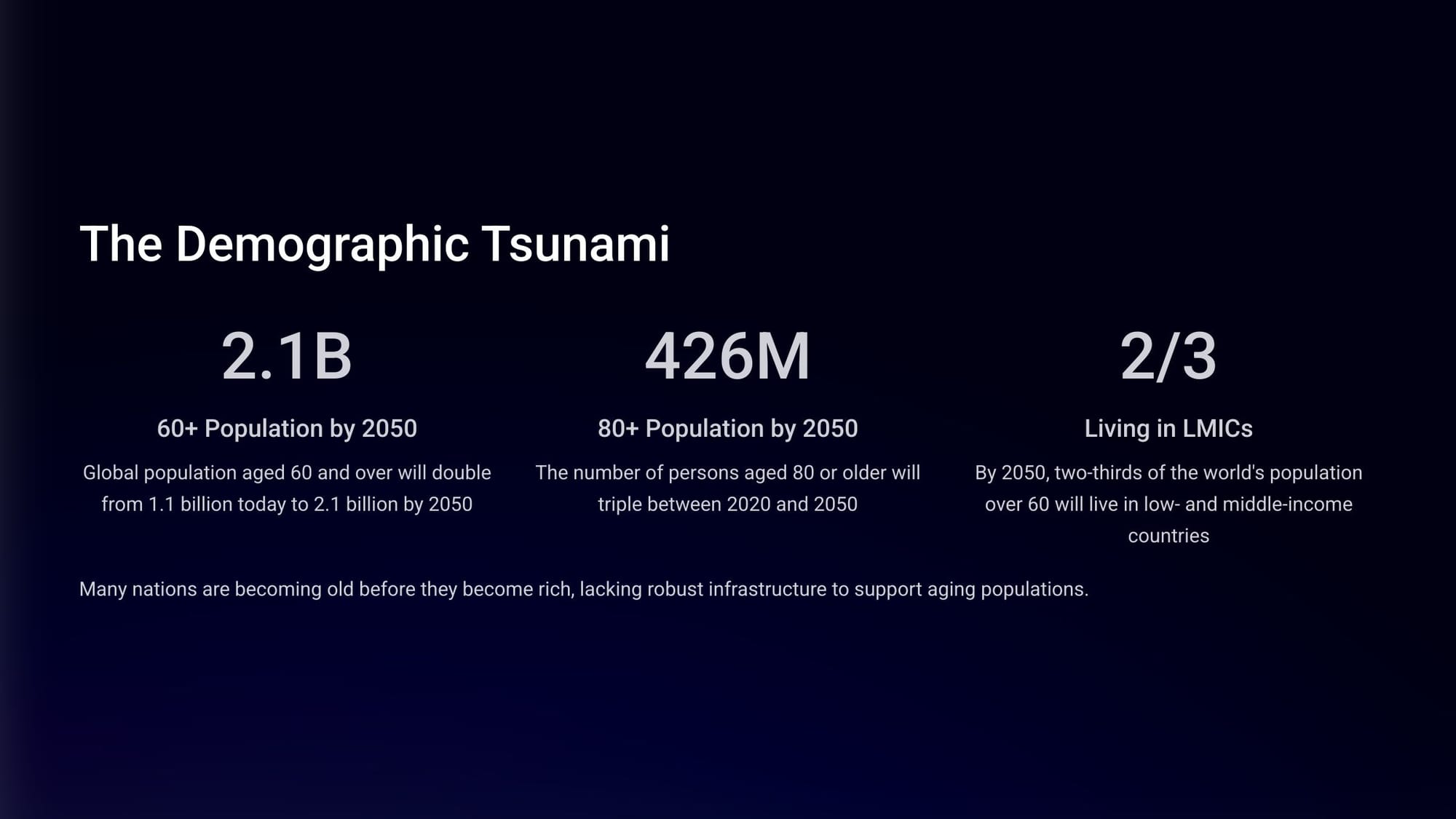
The challenge is that as society ages, brain-related disease accelerates. We may live longer and healthier, but our minds might not be.
What does this lead to? Massive challenge - neurological conditions are now the leading cause of ill health and disability globally, affecting an astonishing 3.4 billion people, or 43% of the world's population. The total amount of healthy life lost due to these conditions—measured in Disability-Adjusted Life Years (DALYs)—reached 443 million in 2021, surpassing cardiovascular diseases. And over 80% of neurological deaths and health loss occur in low- and middle-income countries, where access to diagnosis, treatment, and care is severely limited.
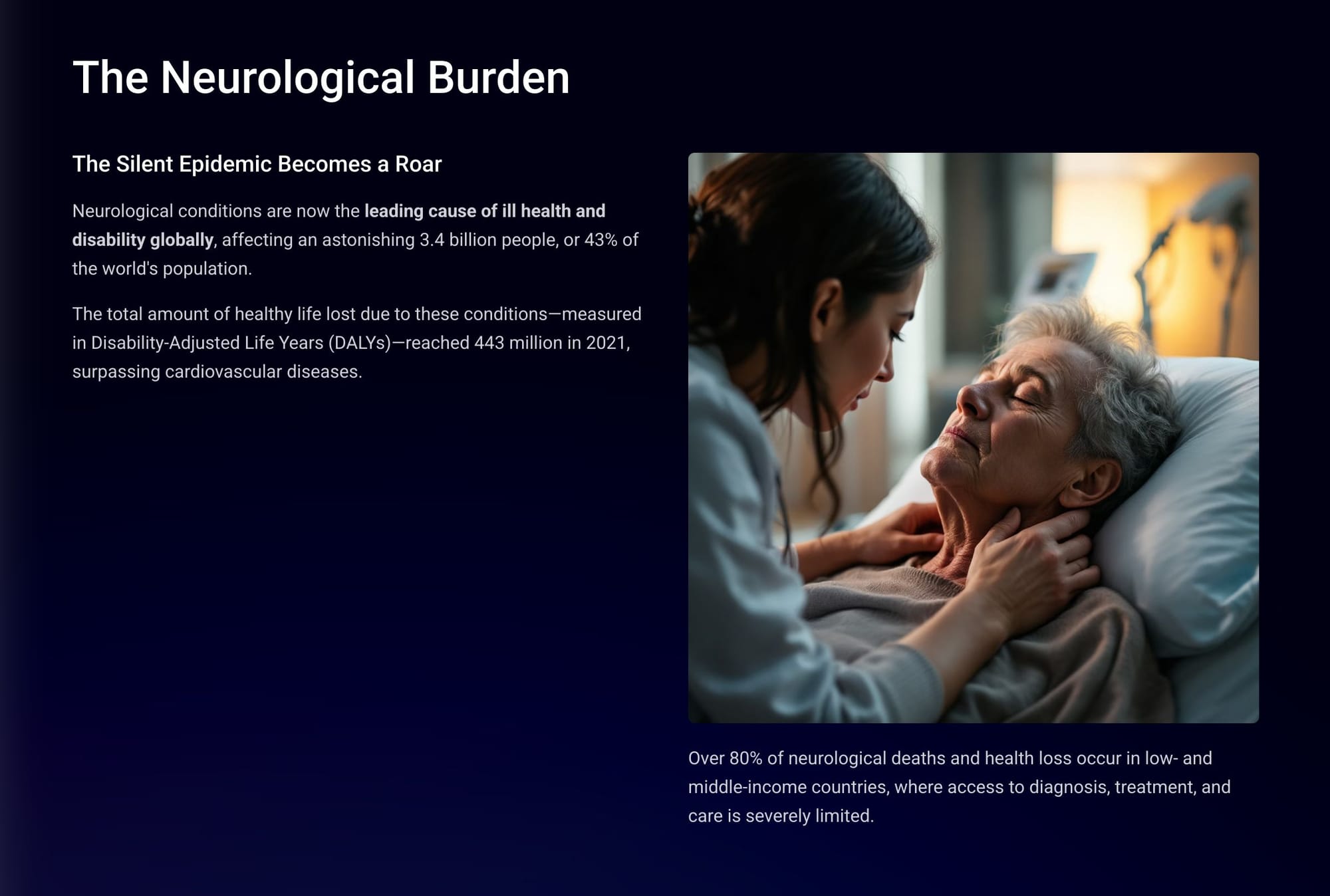
The thing is, the speed with which this challenge is going to accelerate is staggering:
- 2021: 57 million people living with dementia worldwide.
- 2030: Projected to reach 78 million cases globally.
- 2050: Expected to reach 139 million cases, with 71% of the burden in LMICs.
(Note: While age is the strongest risk factor, dementia is not an inevitable consequence of aging, and a significant portion of cases (up to 9%) have a young onset, with symptoms appearing before the age of 65.)
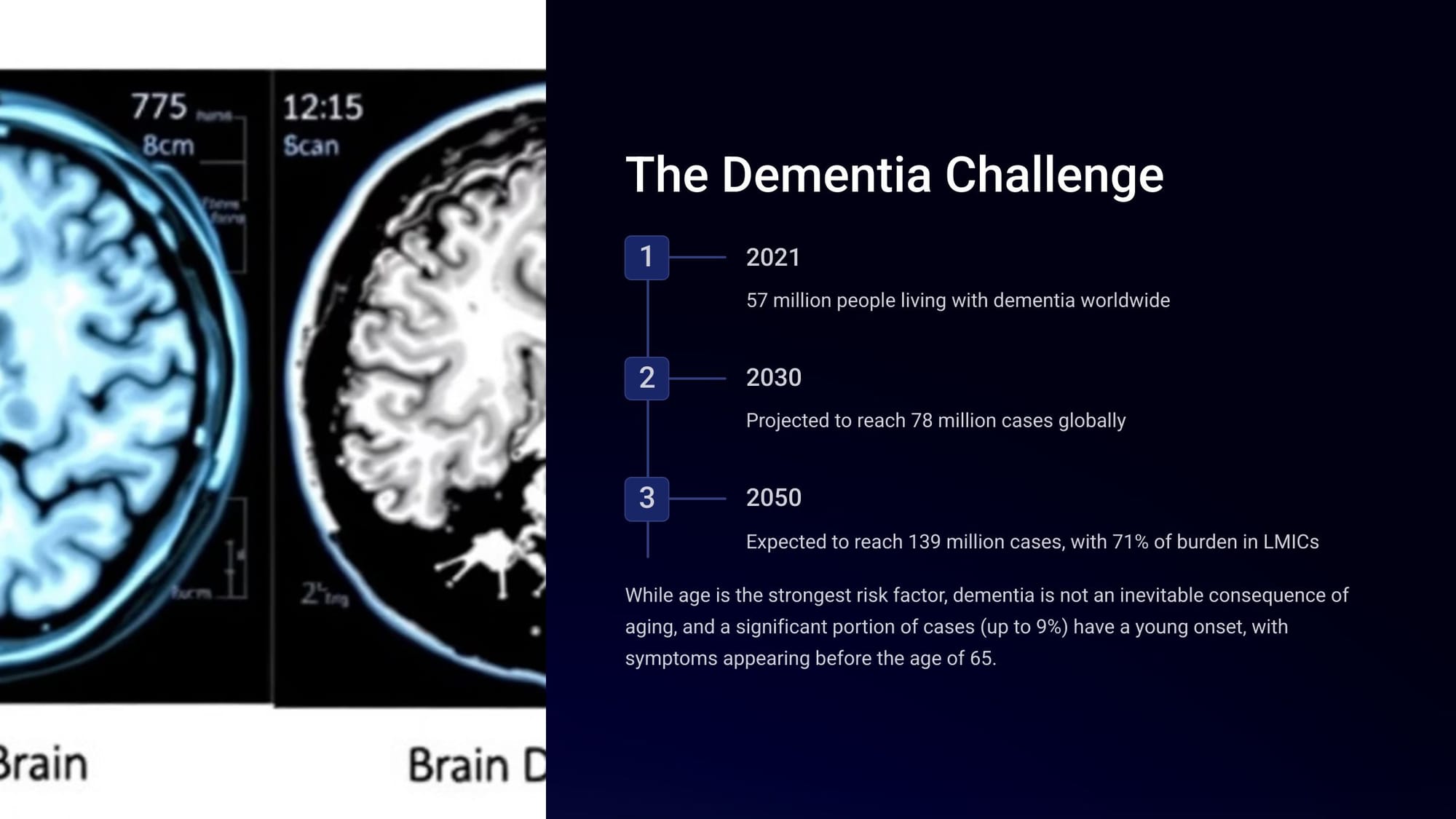
The financial impact of dementia is immense and projected to grow exponentially. If global dementia care were a country, its economy would rank as the 14th largest in the world, larger than the market values of companies like Apple and Google. By 2050, low- and middle-income countries are projected to account for 65% of the total global economic burden.
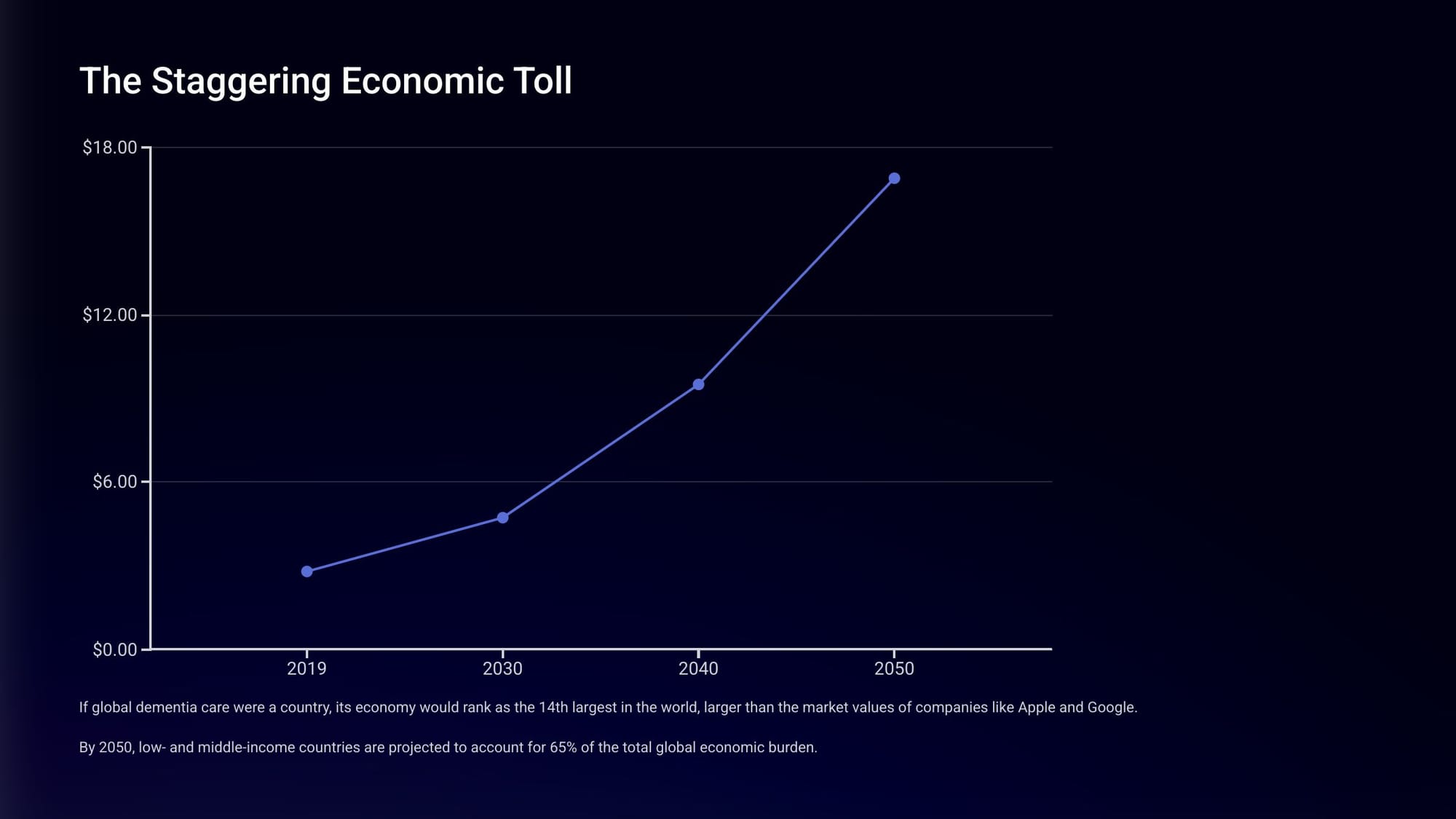
With these harsh realities, it's long been a goal of many in healthcare to "do for brain science this century what we did for heart health in the last century." How do we do that? There are several approaches:e
- Brain-Computer Interfaces: Direct brain-machine communication.
- Focused Ultrasound & Neurostimulation: Direct brain modulation technologies.
- Digital Therapeutics: Software-based interventions with clinical validation.
- Lifestyle Interventions: Physical activity, diet, social engagement, sleep.
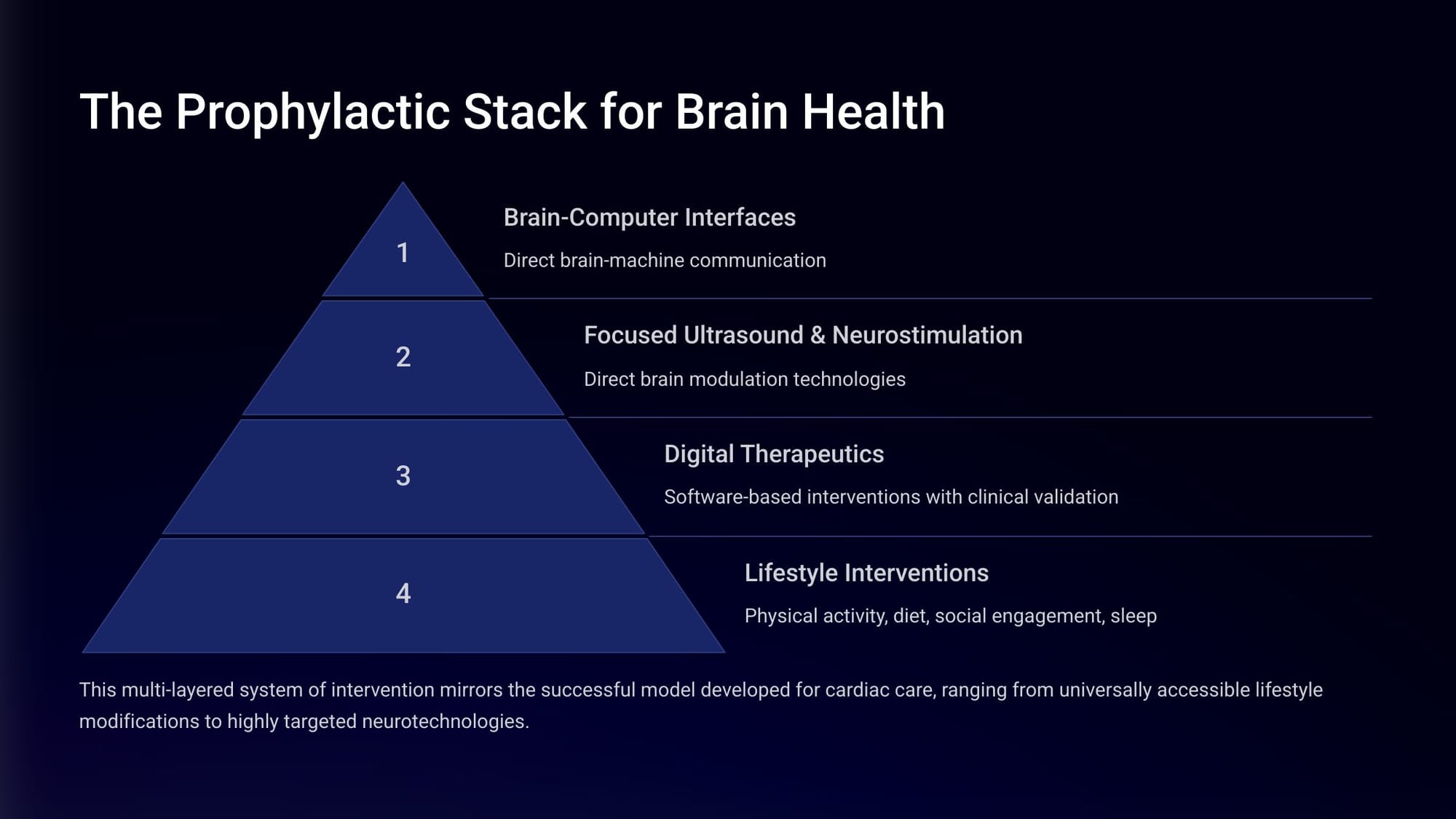
Direct brain interventions involve the rise of "neurotechnology" - that is, technology for the brain itself. Just as we might have a pacemaker for a heart, we can have a 'pacemaker' for a brain that does "Deep Brain Stimulation." This involves surgically implanted electrodes - something we are already doing for things like Parkinson's disease, essential tremor, and epilepsy.
Then there is "Non-Invasive Neurostimulation", involving things like "Transcranial Magnetic Stimulation" and "Transcranial Direct Current Stimulation", both of which can modulate (or change) brain activity without surgery. Early results show promise for improving memory, attention, and treating depression.
Finally, Focused Ultrasound opens the blood-brain barrier to allow drug delivery, perform "knifeless" surgery, or provide non-destructive neuromodulation.

Brain-Computer Interfaces is moving fast - consider the Neuralink project that has the involvement of Elon Musk, which you often see in the news. (Given his inclination for insanity, it's an open question whether you'd want to trust it.) Companies like Neuralink, Synchron, and Blackrock Neurotech are developing invasive or minimally invasive implants that allow patients with paralysis to control computers, robotic limbs, and communication software with their thoughts.
There is also a vibrant and growing market for non-invasive, EEG-based consumer brain-computer-interface headsets, with applications in wellness, meditation, and gaming from companies like Emotiv and Muse.
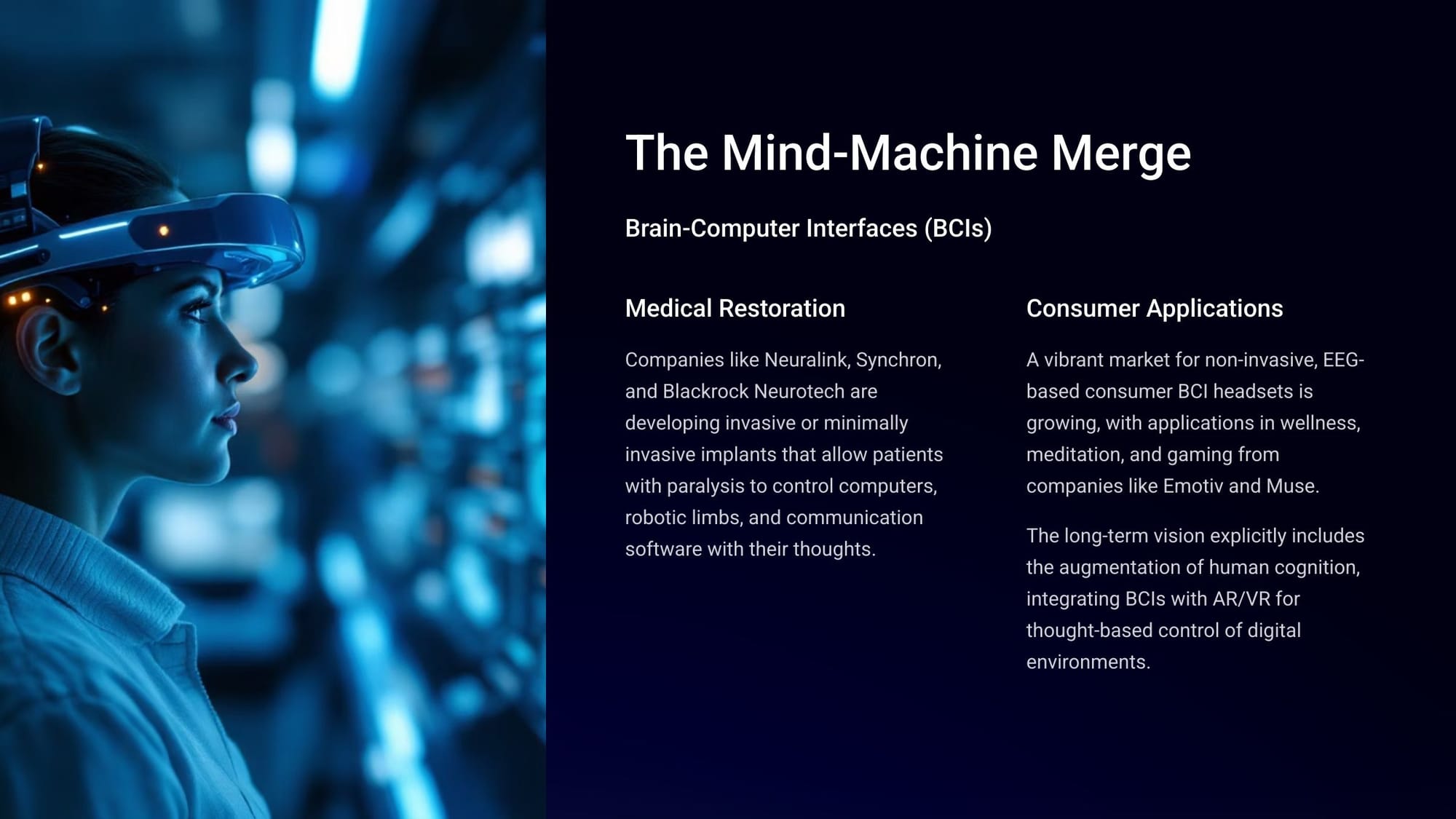
The applications? Many and varied!
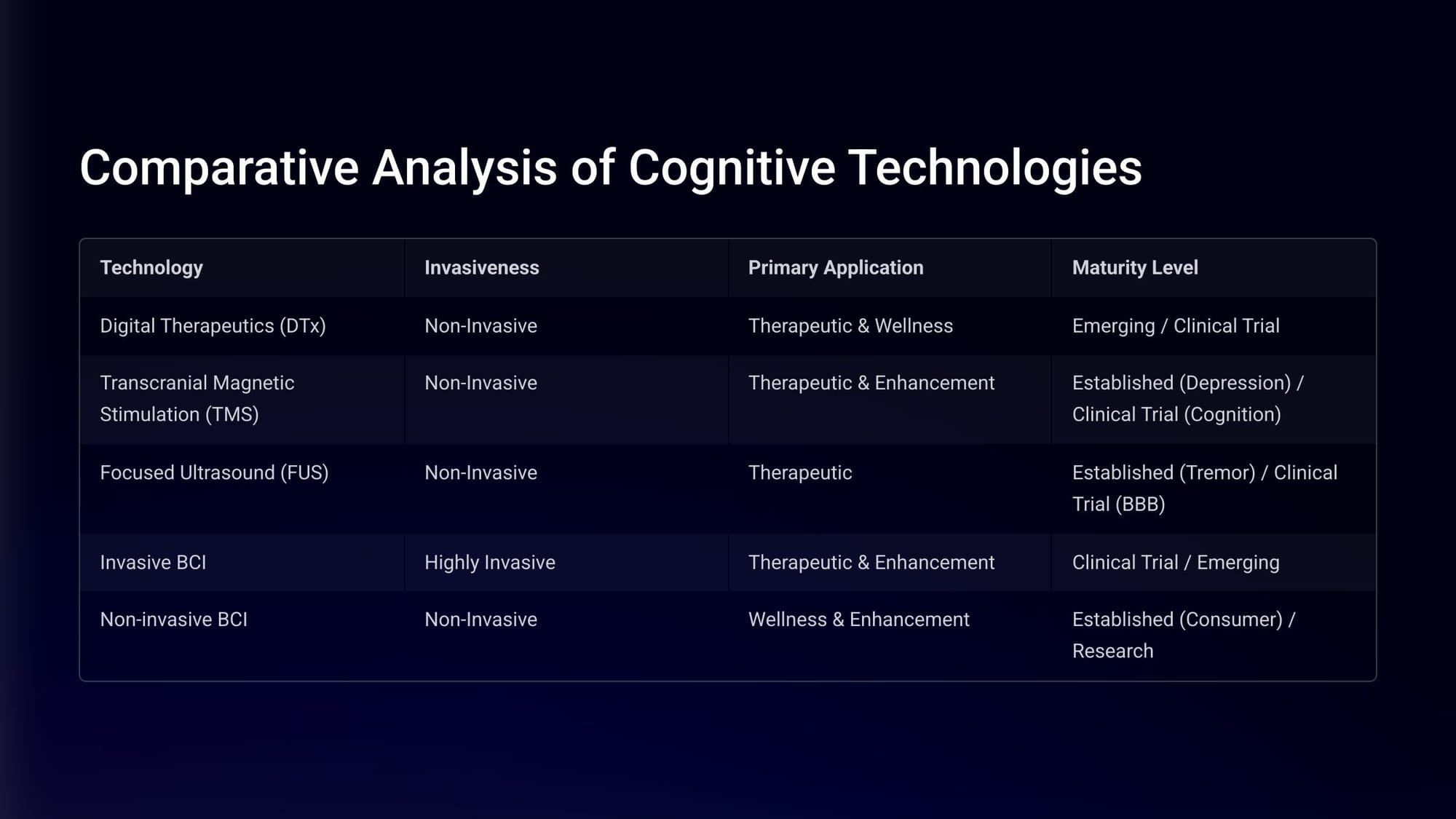
How quickly might all this evolve? Here's some basic insight.
In the Near Term (2025-2028), we'll see "The Era of Scalable Diagnostics & Non-Invasive Wellness."
- Widespread Clinical Adoption of Blood Biomarkers: Blood tests for Alzheimer's risk factors will transition from research tools to standard clinical practice, creating the first truly scalable, population-level brain health monitoring system.
- Explosive Growth in Consumer Neurotech: The market for non-invasive consumer devices, particularly EEG headbands and tDCS systems focused on wellness applications, will see exponential growth.
- First-Generation DTx Reimbursement: Prescription digital therapeutics for cognitive conditions will begin to secure reimbursement pathways in major markets, validating software as medicine.
- FUS in Advanced Clinical Trials: Focused ultrasound for opening the blood-brain barrier will become a standard component in late-stage clinical trials for brain tumors and new Alzheimer's drugs.
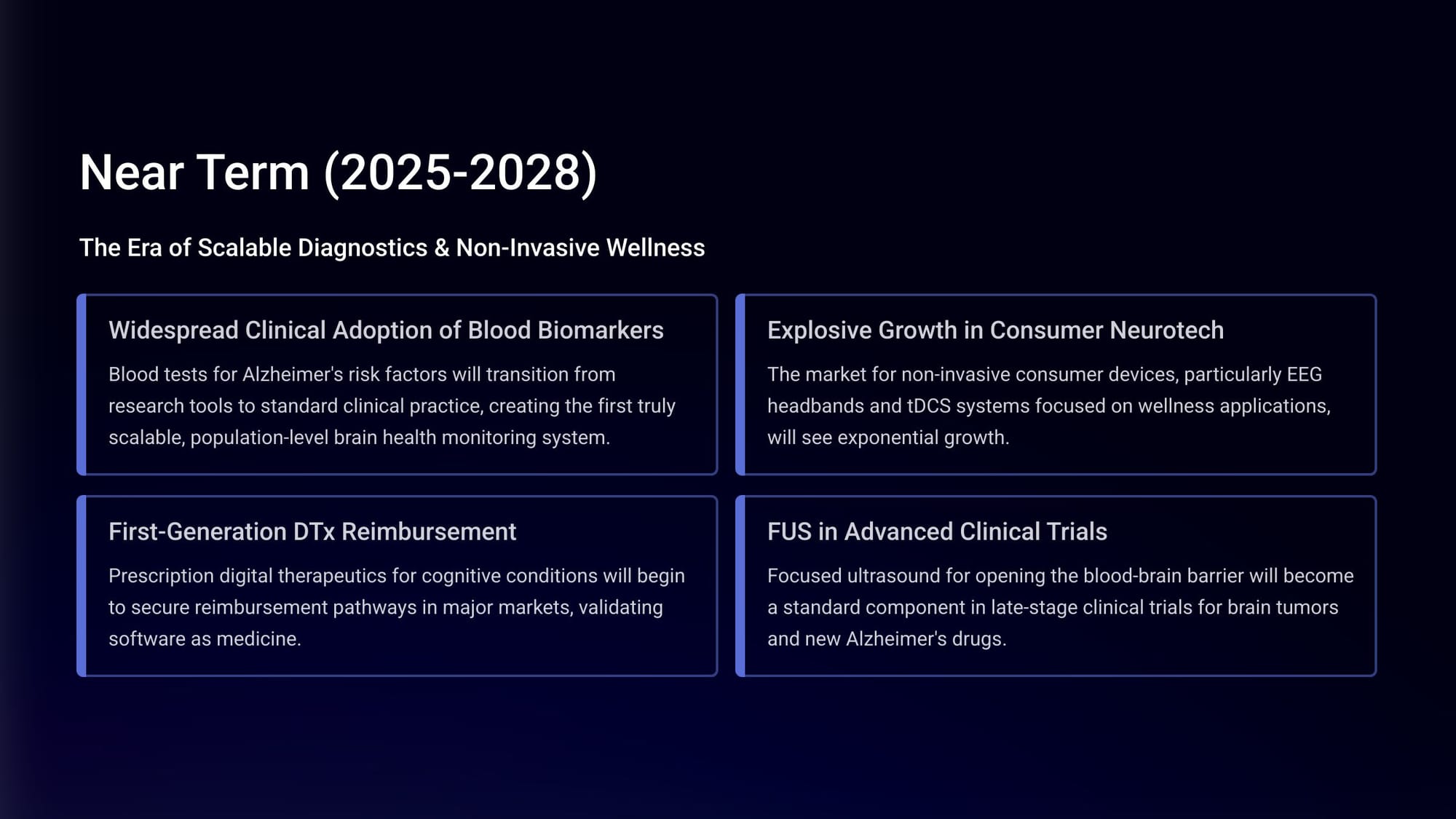
In the mid-term (2029-2032), it's "The Rise of Closed-Loop Neuromodulation & Early BCI Integration."
- "Closed-Loop" Neuromodulation as Standard of Care: Neurostimulation devices will evolve to read neural states in real-time and deliver precise, corrective stimuli, becoming standard for epilepsy and Parkinson's disease.
- Meaningful Consumer BCI Integration: The first consumer-grade BCIs will offer meaningful integration with AR/VR platforms, enabling "thought-based" navigation and hands-free interaction.
- First FUS-Enhanced Drug Approvals: The first pharmaceuticals with FUS-based delivery enhancement will reach the market, creating a new class of "neuro-enabled" drugs.
- Personalized Brain Health Platforms: AI-driven platforms will integrate data from genomics, imaging, blood biomarkers, and lifestyle wearables to generate personalized "brain health scores."
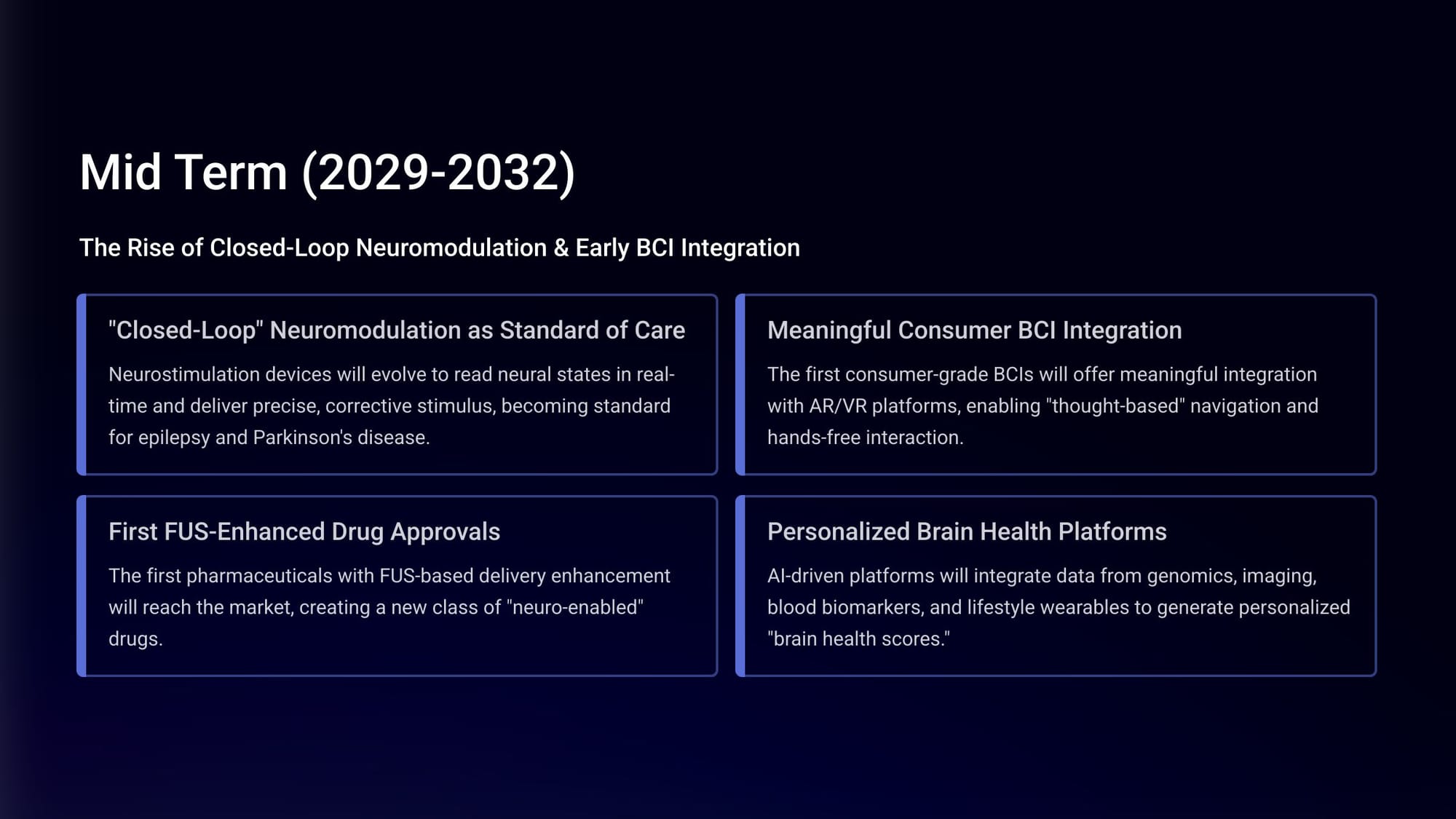
And finally, in the longer term (2033-2035), some suggest we will be in "The Dawn of Cognitive Augmentation."
- Cognitive Enhancement in Professional Settings: High-resolution BCIs will begin to see adoption for genuine cognitive enhancement in high-performance professional fields, such as augmenting a surgeon's focus or a pilot's attention.
- Prescription Cognitive Maintenance: Personalized cognitive training programs combined with tailored neurostimulation will become common prescriptions for individuals at high risk of cognitive decline.
- The "Cognitive Divide" as Public Policy: The societal gap between those with and without access to enhancement technologies will become a major topic of public policy debate, forcing governments to grapple with questions of equity and fairness.
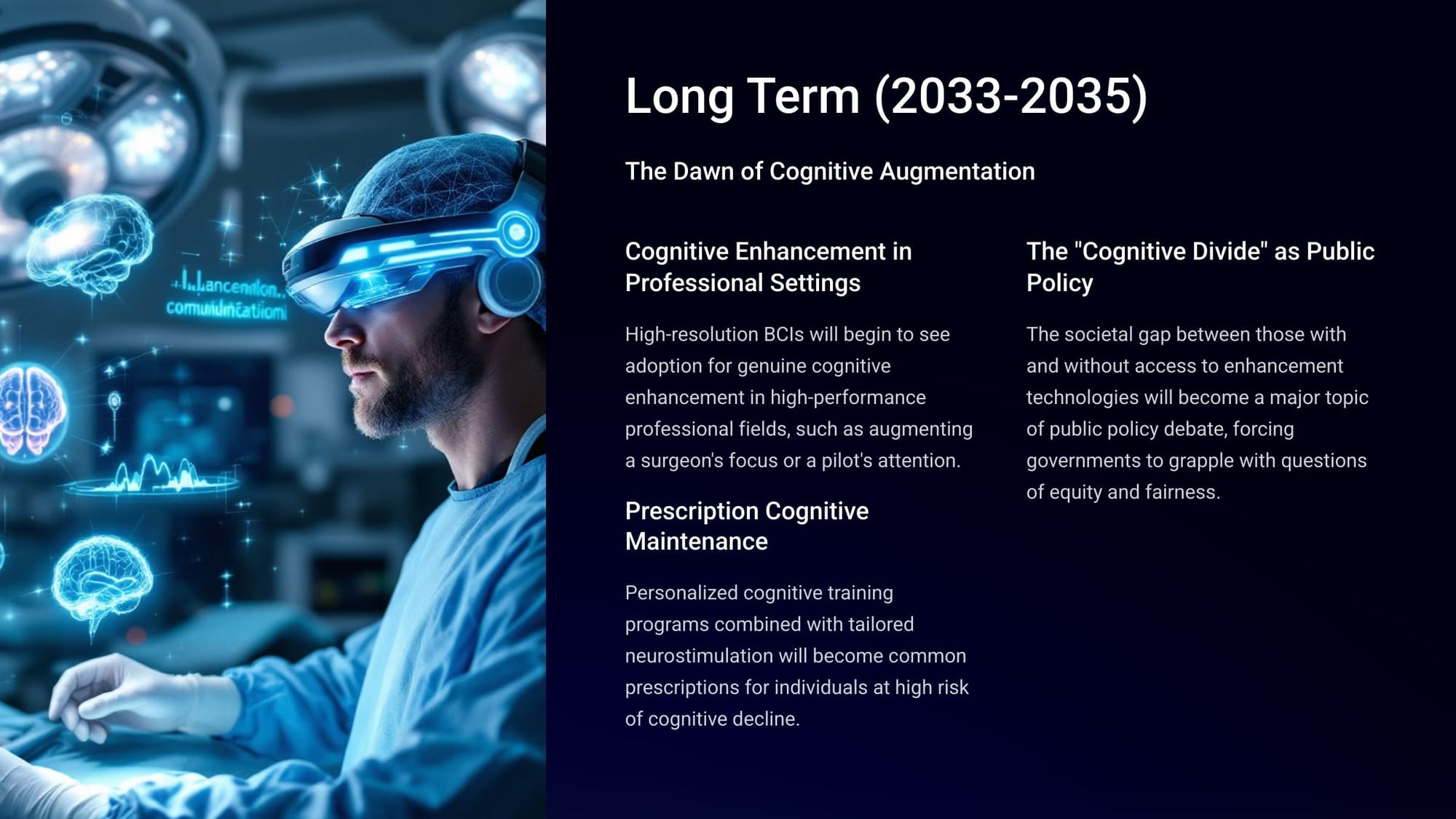
Is this all a pipe dream? Not to a lot of scientists and medical professionals, who believe that the path forward for brain health mirrors the successful public health revolution for heart health in the 20th century. Remember, it involved a multipronged approach involving
- Identified risk factors (cholesterol, blood pressure)
- Developed scalable diagnostics (EKG, stress tests)
- Created preventative interventions (statins, lifestyle)
- Launched massive public health campaigns
With that, cardiovascular disease transitioned from an acute, often fatal event to a largely manageable and preventable condition. The same thing is happening in the 21st century with "brain health."
- Identifying risk factors (biomarkers, genetics)
- Developing scalable diagnostics (blood tests, imaging)
- Creating preventative interventions (neurotechnology)
- Building public awareness and education
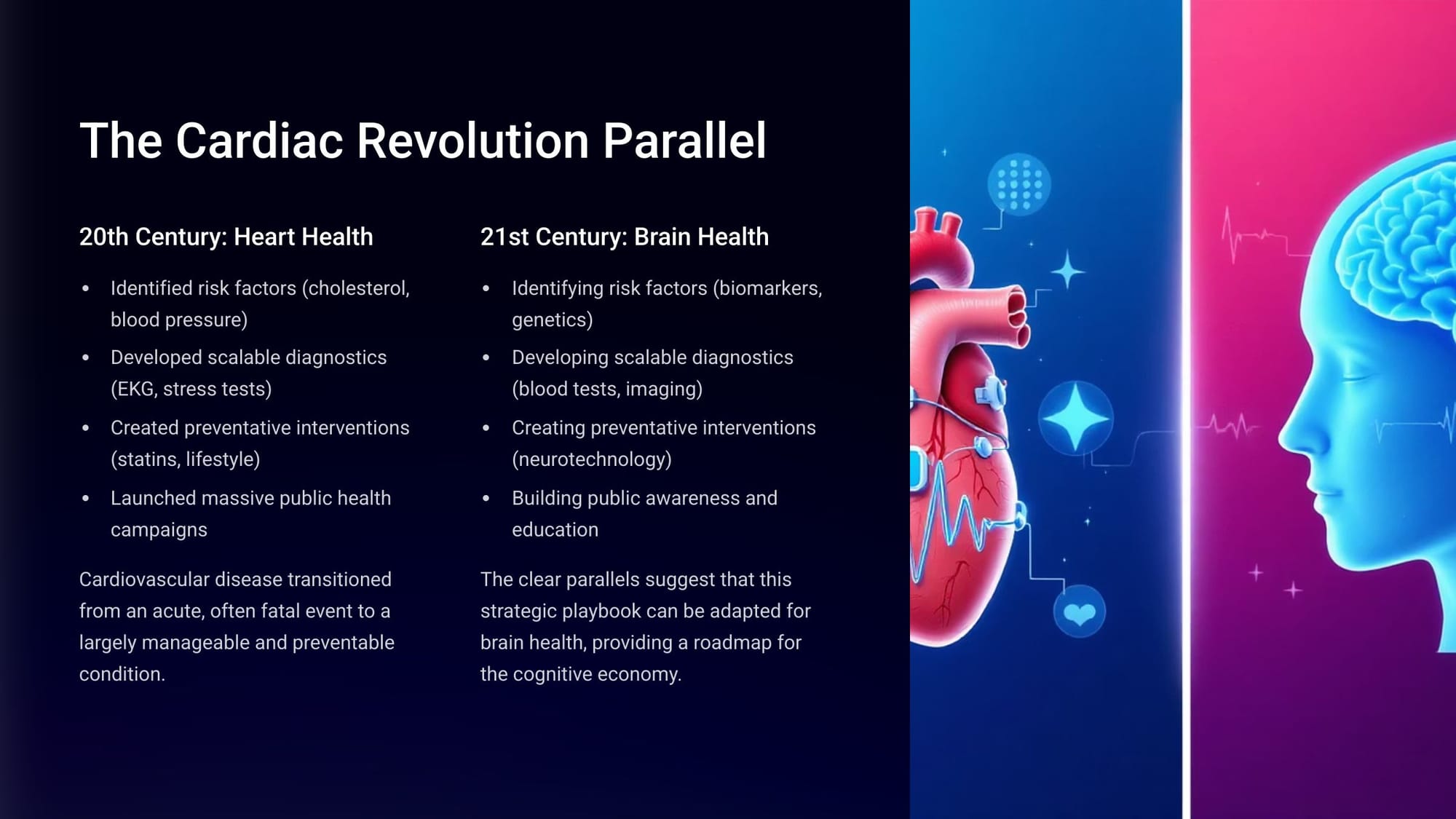
The clear parallels suggest that this strategic playbook can be adapted for brain health, providing a roadmap for the cognitive economy! With that being the case, it's a megatrend focused on solving a mega-problem!
Futurist Jim Carroll believes that the acceleration of brain science, particularly to deal with the acceleration of brain disease happening with aging and longevity, will prove to be one of the most remarkable scientific advances of our time.

